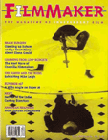 Back to selection
Back to selection
FILMMAKER FLASHBACK: WINTER, 1994
Leading up to our 18th birthday, I’ll be revisiting on the blog one issue of Filmmaker a day. Today’s is Winter, 1994.
 Today, most of our Filmmaker covers are original photography, but back in the day, we didn’t have the budget and were forced to work with supplied art from distributors. Scott McGehee and David Siegel, who went on to The Deep End, Bee Season, and, most recently, Uncertainty, made their debut with Suture, a formally challenging meta-thriller with a wobbly poster that produced for us a somewhat inscrutable cover. We took their key art, cropped it, colorized it yellow and produced a kind of newsstand Rorschach test.
Today, most of our Filmmaker covers are original photography, but back in the day, we didn’t have the budget and were forced to work with supplied art from distributors. Scott McGehee and David Siegel, who went on to The Deep End, Bee Season, and, most recently, Uncertainty, made their debut with Suture, a formally challenging meta-thriller with a wobbly poster that produced for us a somewhat inscrutable cover. We took their key art, cropped it, colorized it yellow and produced a kind of newsstand Rorschach test.
I wonder how many people remember this film? It told the story of two half brothers, one black (played by 24‘s Dennis Haysbert) and one white (Michael Harris). After the white brother commits a murder, he decides to fake his death and frame his “lookalike” brother for it, and the film takes as completely matter-of-fact that the two men look exactly alike. The film is both a psychological mindbender as well as a playful riff on film theory, exploring the relationship between narrative, identity and identification. It refers to films like The Passenger and Seconds, but, looking back, one can also see it as part of a line that today includes Chris Nolan’s work in films like Memento and Inception. For our cover, Peter Bowen wrote about it and Francois Girard’s 32 Short Films about Glenn Gould‘s use of film theory in their stories.
Also in this issue were Mike Leigh’s Naked and Atom Egoyan’s Calendar plus the next in Peter Broderick’s series of articles on the new no-budget filmmaking. “Learning from Low Budgets” is not on our site but it is on his. In writing about the production methodologies of three movies — Clerks; Clean, Shaven; and Grief — Broderick saw them as part of a sea change that took place at the 1994 Sundance Film Festival. He wrote:
Of the 16 films selected from hundreds of entries for the dramatic competition at Sundance, half were made for extremely low budgets. In fact, $500,000 was the combined total of the cash budgets (not including deferments) of seven of these features, the lowest budget being $27,575 for Clerks. Two budget categories $1.5 to $3.5 million, and $500,000 to $ 1.5 million that were very significant in previous Sundance dramatic competitions, are barely represented in 1994. This year there is just one film in the first category and only two or three in the second. Never before has the festival competition included so many films made for so little.
The Sundance selections (including a number of very low-budget features being shown out of competition) signal a radical shift in independent production. This marks a dramatic departure from the previous era in which higher-budgeted Off Hollywood films were dominant. Despite a few very lowbudget successes, the conventional wisdom was that at least $250,000 was needed to make a feature. The influential book Off Hollywood: The Making and Marketing of’ Independent Films (published by the Sundance Institute and the IFP) included case studies of nine fiction features made in the late ‘70s and early ‘80s. Their cash budgets ranged from $250,000 to $1.2 million (with the sole exception being the $60,000 Return of the Seacacus Seven).
Now that a new era of ultra lowbudgeters has dawned, budgets seem to “have dropped a zero” as Islet president John Pierson puts it. $250,000 features have been replaced by $25,000 features, and $1,000,000 budgets are rarer than $100,000 budgets, as Off Off Hollywood films eclipse Off Hollywood films.
